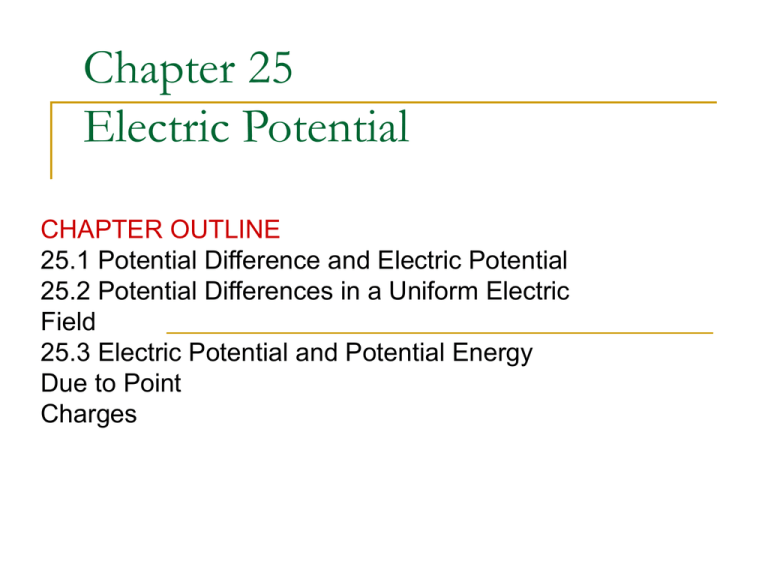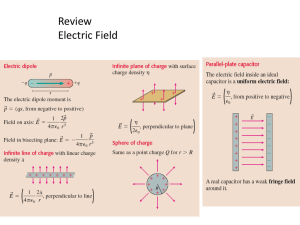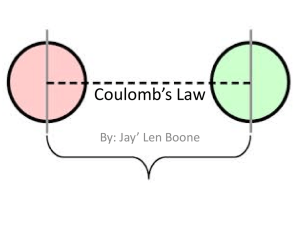The Electric Potential
advertisement

Chapter 25 Electric Potential CHAPTER OUTLINE 25.1 Potential Difference and Electric Potential 25.2 Potential Differences in a Uniform Electric Field 25.3 Electric Potential and Potential Energy Due to Point Charges 25.1 Potential Difference and Electric Potential The Electric Potential Moving an electric charge through space where electric fields are present can require work, since forces associated with the fields act on the charge. This work can be described as a change in potential energy. We introduce the new concept of “electric potential” to describe the amount of work needed to move a charge through a region with electric fields. Two parallel metal plates containing equal but opposite-sign charges produce a uniform electric field in the region between the plates. “CAPACITOR” (This is a convenient device that allows us to talk about a region where the electric field does not change. This makes the calculations much easier.) An external force F, equal in magnitude to the electrostatic force qE, is used to move the charge q a distance d in a uniform field. The increase in potential energy when a charge q is moved against the electrostatic force is analogous to what happens when a mass m is lifted against the gravitational force. We call this the electrostatic potential energy (instead of the gravitational potential energy). The Electric Potential The work done by the electric field on the charge is The potential energy of the charge–field system is changed by an amount this line integral does not depend on the path taken from A to B. The potential difference The change in electric potential is equal to the change in electrostatic potential energy per unit of positive test charge: U V q This is the definition of potential. It is measured in volts. The potential difference ΔV = VB - VA between two points A and B in an electric field is defined as the change in potential energy of the system when a test charge is moved between the points divided by the test charge q0: Electric potential is a scalar characteristic of an electric field, independent of any charges that may be placed in the field. The work done by an external agent in moving a charge q through an electric field at constant velocity is The SI unit of the electric potential is energy per unit charge and potential difference is joules per coulomb, which is defined as a volt (V): The electron volt is related to the joule as follows: Example: The electric potential (represented by the dashed lines of constant potential) increases as we move closer to a positive charge. a . b . What is the potential difference in moving From a to b. 1. 15 V 2. -15V 3. 25 V 4. -25V 5. Can tell not in a straight line Example: a . b . What is the work done in moving a +2 coulomb charge from a to b? 1. 50 J 2. 30 J 3. 25 J 4. 20 J 5. 15 J If 500 J of work is required to carry a 40 C charge from one point to another, the potential difference between the two points is 1. 12.5 V 2. 20,000 V 3. 0.08 V 4. depends upon the path 5. none of these 25.2 Potential Differences in a Uniform Electric Field The potential difference between two points A and B separated by a distance IsI = d, where s is parallel to the field lines. Now suppose that a test charge q0 moves from A to B. We can calculate the change in the potential energy of the charge–field system: From this equation if q0 is positive, then ΔU is negative This means system consisting of a positive charge and an electric field loses electric potential energy when the charge moves in the direction of the field. And If q0 is negative, then ΔU is positive A system consisting of a negative charge and an electric field gains electric potential energy when the charge moves in the direction of the field. All points in a plane perpendicular to a uniform electric field are at the same electric potential Rank in order, from largest to smallest, the potential differences ∆V12, ∆V13, and ∆V23 between points 1 and 2, points 1 and 3, and points 2 and 3. 1. ∆V12 > ∆V13 = ∆V23 2. ∆V13 > ∆V12 > ∆V23 3. ∆V13 > ∆V23 > ∆V12 4. ∆V13 = ∆V23 > ∆V12 5. ∆V23 > ∆V12 > ∆V13 Example 25.2 Motion of a Proton in a Uniform Electric Field Homework: 25.3 Electric Potential and Potential Energy Due to Point Charges Electric Potential due to point charges The electric potential created by a point charge at any distance r from the charge is The total electric potential at some point P due to several point charges is the sum of the potentials due to the individual charges Potential Electric due to point charges Note that if the charges are of the same sign, U is positive. This is consistent with the fact that positive work must be done by an external agent on the system to bring the two charges near one another (because charges of the same sign repel). If the charges are of opposite sign, U is negative; this means that negative work is done by an external agent against the attractive force between the charges of opposite sign as they are brought near each other—a force must be applied opposite to the displacement to prevent q1 from accelerating toward q2. The total potential energy of the system of three charges is: Example 25.3 The Electric Potential Due to Two Point Charges







